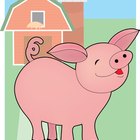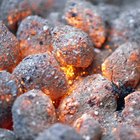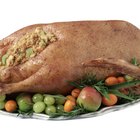
Cooking a goose takes some thought and preparation, because of its unusual anatomy. Goose meat itself is lean and dark, and can easily dry out if it's overcooked. Yet the skin is insulated by a thick layer of fat, which must be rendered out to make the goose edible. Geese are usually roasted in an oven, but cooking one on your grill can give the bird a better flavor. You'll need a large drip pan to catch the goose fat, and it will need regular attention to avoid flare-ups.
Without a Rotisserie
Step 1
Build a bed of coals in your cooker, then rake them to one side so the goose can cook on the other side in indirect heat. On a two-burner gas grill, light one side but not the other. On a three- or four-burner gas grill, light the outside burners but leave the middle ones off. Preheat your grill to 400 degrees Fahrenheit, adjusting the vents or burners as needed.
Step 2
Dry the goose inside and out with clean paper towels, and remove any excess skin or easily-accessible fat deposits. Prick the goose's skin thoroughly with a fork or the point of a bamboo skewer, or score it lightly in diagonal lines or a cross-hatch pattern with the blade of a sharp knife. Whichever method you use, take care just to pierce the skin and not the flesh of the goose.
Step 3
Season the goose inside and out with pepper and coarse salt, or other seasonings if desired. Place the rack in a deep roasting pan. You'll need lots of room for drippings, so raise the rack if necessary with tight balls of aluminum foil. Center the goose on the rack, and place the pan on the unheated side of your grill.
Step 4
Add a few pieces of hardwood to generate smoke, if desired, and close the lid. Reduce the heat of your grill to 350 F by adjusting the burners or vents. Roast the bird for one hour, then open the lid and use a ladle or heatproof basting bulb to extract some of the fat from the bottom of the roasting pan. This reduces the likelihood of it overflowing or causing flare-ups.
Step 5
Roast the goose for another 90 minutes to two hours, depending on its size, until in instant-read thermometer inserted into the thickest part of the thigh reads 165 F. If the goose's skin is not well-crisped and browned, remove any excess fat from the pan and increase your heat to 450 F for a few minutes to finish browning.
Step 6
Rest the goose under a loose cover of aluminum foil for 15 minutes before carving it.
With a Rotisserie
Step 1
Set up your grill for indirect roasting by building a bed of coals on one side of your cooker, away from the position where your rotisserie will hold the goose. In a gas grill, light only the burners that will not be directly underneath the goose. Adjust your grill's vents or burners until you've reached a steady 400 degrees Fahrenheit.
Step 2
Dry the goose inside and out with clean paper towels, then score or puncture the skin to let the fat render out. Season the bird with coarse salt, pepper or other ingredients as desired.
Step 3
Slide the spit rod through the goose's body cavity, then truss the legs and wings neatly into place with butcher's twine. Slide the rest of the spit assembly's prongs and restraints into place to hold the goose tightly onto the spit.
Step 4
Open the lid of your grill and snap the spit into the rotisserie motor. Place a deep roasting pan under the goose to catch the fat as it drips. Place a few hardwood chips or pellets on the coals, if you wish, for a smoky flavor. Close the lid, and adjust the vents or burners to bring the cooking temperature down to 350 F.
Step 5
Open the lid after the first hour and use a ladle or heatproof basting bulb to remove most of the goose fat from the dripping pan. Close the lid and roast for another 1 1/2 to 2 hours, removing excess fat periodically, until an instant-read thermometer inserted into the goose's thigh reads 165 F.
Step 6
Remove the goose from the spit and transfer it to a serving tray. Cover it lightly with aluminum foil and let it rest for 15 minutes before carving.
Related Articles
How to Cook Prime Rib on an Electric ...

Can I Cook Duck in Low Temperatures to ...

How to Cook Lamb Tongue in a Pressure ...

How to Barbecue Roast Beef

How to Cook a Wild Goose in a Slow ...

How to Make Homemade Propane Pig Cookers

How to Cook Turkey Legs on the Grill
How to Barbecue Prime Rib Bones

How to Cook a Crispy & Juicy Whole Duck

How to Cook Barbecue Chicken Drumsticks ...

How to Cook Quail on a Grill

How Long to Cook a Suckling Pig on a ...

How to Cook Fresh Brook Trout

How to Bake Goose Breasts

How to Cook a Beef Roast Over an Open ...

How to Cook a Beef Topside Roast

How to Cook Filet Mignon Medallions on ...

How to Cook Prime Rib Using an Oven ...

How to Cook a Bottom Round Roast on a ...
How to Cook Deer Rib
References
- Larousse Gastronomique; Prosper Montangnee (Ed.)
- The Ultimate Rotisserie Cookbook: 300 Mouthwatering Recipes for Making the Most of Your Rotisserie Oven; Diane Phillips
- Schiltz Foods: Cooking Tips
- Traeger Wood Pellet Grills: Roast Goose
- National Public Radio: How to Cook Your Goose
Tips
- To help the goose's skin brown and crisp, sprinkle it lightly with coarse salt the night before roasting it and leave the goose uncovered in your refrigerator. The salt draws moisture from the skin, which then evaporates in the refrigerator's arid atmosphere. The dried skin crisps and browns readily, and absorbs more smoke flavor from the grill.
- Save the fat from your goose and use it sparingly for frying or roasting potatoes, onions or root vegetables. It lends a rich depth of flavor no other cooking fat can equal.
- If you opt to add hardwood chips to your grill for smoke, use lighter-flavored woods such as alder, apple or other fruit woods. Oak and hickory can be too strong and harsh, overpowering the flavor of the goose. On a gas grill, wrap the hardwood in heavy foil and puncture it in several places. Put the foil-wrapped package over the gas flame.
Writer Bio
Fred Decker is a trained chef and prolific freelance writer. In previous careers, he sold insurance and mutual funds, and was a longtime retailer. He was educated at Memorial University of Newfoundland and the Northern Alberta Institute of Technology. His articles have appeared on numerous home and garden sites including GoneOutdoors, TheNest and eHow.
Photo Credits
Eising/Photodisc/Getty Images